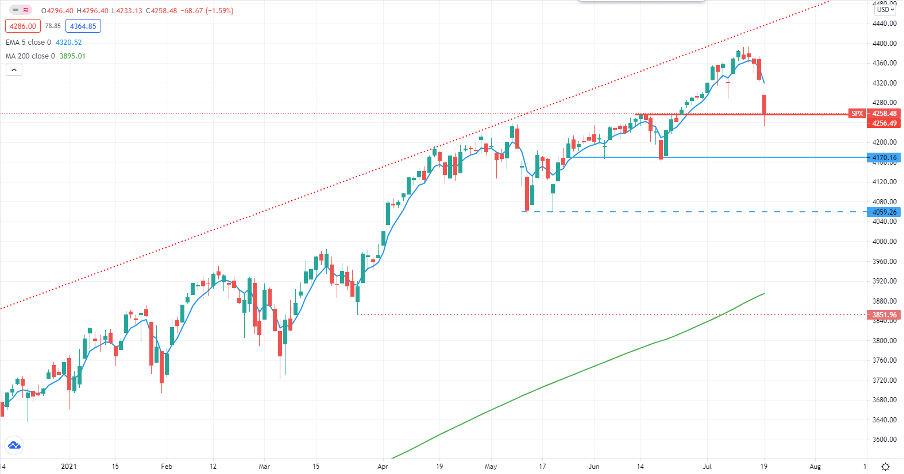Low market participation and poor market breadth that has supported risks assets, has finally snapped and it’s been a while since we saw the bid come out of the market and correlations moving closer to one.
The bears have relished this, although we did see some buying of risk towards the close (the S&P 500 lifted from 4235 to 4258 in the final 30 minutes) which may have given the bulls some hope (markets that close on their lows usually head further lower) – hope is not a strategy though and we need to see how Asia trades this move – the session ahead could be very insightful indeed.
Daily of the S&P 500

(Source: Tradingview)
The VIX index had pushed up 6.5 vols to 25% but found sellers into the equity close on the back of the S&P 500 move, but ultimately closed at 22.50% (+4.05 vols) - it still tells you about the demand for downside portfolio protection and that traders see movement, with the S&P 500 priced for a 1.41% average move over the coming 30-days. This would have invariably led to systematic players and volatility-targeting funds reducing long exposures and there would also be some hedging flow from the options world playing into this too.
Flow aside, classic safe havens like the JPY, CHF and USD are outperforming, AUDJPY is -1.2%, it’s hard to find many bright spots in the equity world (Tesla is +0.3%, GME +2.6%), copper is -2.6%, the S&P 500 closed -1.6%.
The US bond market tells the story clear as day, with 10yr Treasuries -10bp into 1.19%, and finding a relentless bid through Europe and again through US trade. The 2s vs 10s yield differential is -8bp and below 100bp and the bull flattening of the Treasury curve has been the macro focus du jour.
US 10yr -2yr yield differential

(Source: Tradingview)
US and global Q3 growth being priced out
The narrative is that we’ve known that US and global growth has evidently slowed into Q2, with the credit impulse driving the worry (notably from China). However, the market has strongly believed and been positioned for the economic re-opening trade – given current dynamics and news flow, the Delta variant is causing this exposure and the idea of limited lockdowns (certainly in the US) to be called into question and the US and global Q3 growth uplift is being priced out.
It may be too much to say the flattening of the bond curve is the market pricing stagflation (high inflation, low growth), which is perhaps the worst backdrop for equity and risk asset (such as commodity CFDs) performance, but it can't be far off the mark. It's clearly portrays inflationary pressures sticking around for longer than many policymakers initially expected, and transitory may mean far longer than many think. Subsequently, a normalisation of central bank policy into a period of slower growth is one risk assets do not enjoy – when in doubt, take risk off the table and we’re seeing that amid a backdrop of summer liquidity.
Crude (-7%) fared its worst day since April 2020 and has been well traded by clients – I personally don’t put the move down to the OPEC agreement, which was expected and met prior expectations – but more so on the growth concerns that naturally feed into the supply/demand dynamic. WTI crude holds the $66.50 support, for now, and if this bounces it may bring some risk back into markets, but if this gives way it will just accelerate the need to de-risk and safe havens and long vol strategies/beneficiaries will find further upside.
Without any major US data due until the Fed meeting (29 July) it's hard to see a huge reversal in US bonds, but they overbought here and that may curb downside (in yields) – but we’re back to watching COVID trends, hospitalisation rates, and the prospects of lockdowns. This plays into consumer behaviour and the idea that growth in Q3 and Q4 slows down, which would need a pivot from central banks to acknowledge these risks. Until then the idea of near-term inflationary pressures and unanswered questions on the impact of the delta variant should keep volatility elevated.
My colleague, Research Strategist Luke Suddards, gave a view on this earlier which may be of interest.
Ready to trade?
It's quick and easy to get started. Apply in minutes with our simple application process.
The material provided here has not been prepared in accordance with legal requirements designed to promote the independence of investment research and as such is considered to be a marketing communication. Whilst it is not subject to any prohibition on dealing ahead of the dissemination of investment research we will not seek to take any advantage before providing it to our clients.
Pepperstone doesn’t represent that the material provided here is accurate, current or complete, and therefore shouldn’t be relied upon as such. The information, whether from a third party or not, isn’t to be considered as a recommendation; or an offer to buy or sell; or the solicitation of an offer to buy or sell any security, financial product or instrument; or to participate in any particular trading strategy. It does not take into account readers’ financial situation or investment objectives. We advise any readers of this content to seek their own advice. Without the approval of Pepperstone, reproduction or redistribution of this information isn’t permitted.


